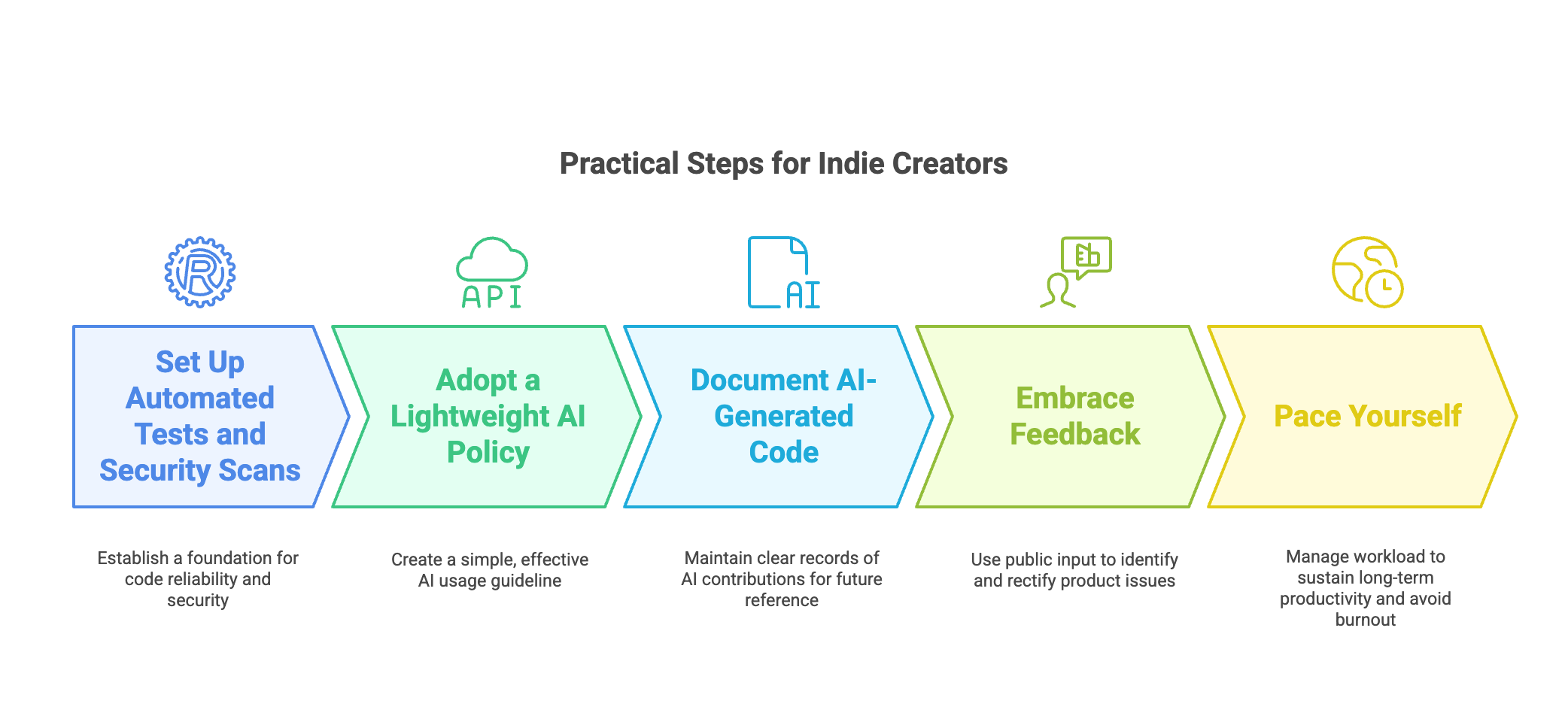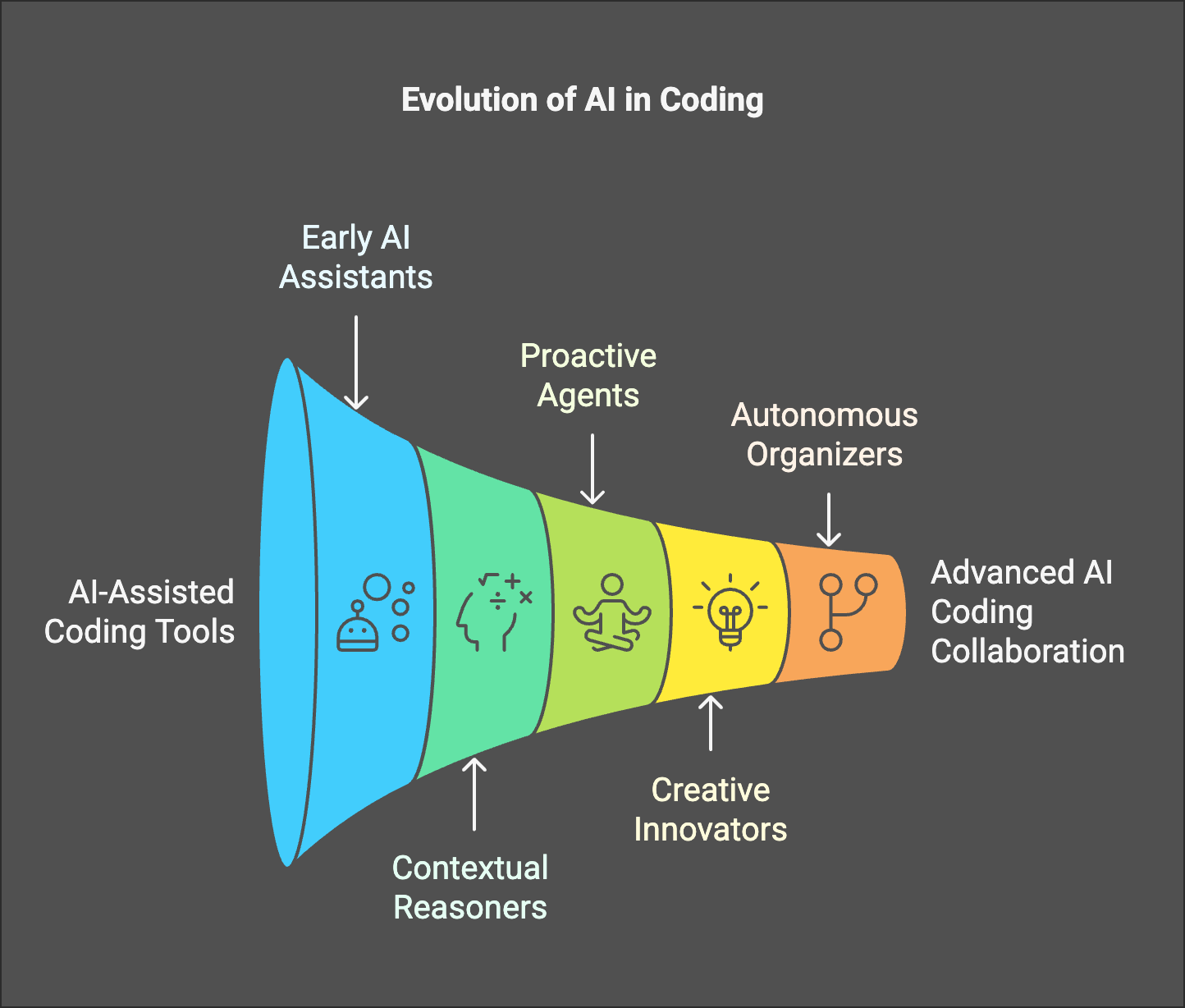AI, Indie Hacking, and Building in Public: Navigating Growth, Guardrails, and Gratitude

In the age of skyrocketing AI adoption, it can feel like the software world is in free fall. Excitement and suspicion collide: code is generated faster than ever, yet debugging burdens grow; new AI products appear overnight, but so do new security, privacy, and governance concerns. For an indie hacker, the allure of AI coding assistants is almost irresistible: we’re small, we want to move fast, and there’s no huge security bureaucracy to slow us down. That autonomy can be liberating, but it also comes with unique risks and responsibilities.
Inspired by findings from Harness’s State of Software Delivery 2025 and my own experiences “building in public,” this post explores how we, as small-scale creators, can leverage generative AI responsibly. My aim is to offer a balanced perspective—one that combines the speed and enthusiasm of a startup with enough guardrails to keep our projects (and our mental health) on track.
The Promise and Peril of Generative AI
Generative AI has accelerated coding like never before: even mid-level developers can spin up MVP features in a weekend. This is a boon for those of us building solo or in small teams. We can introduce new features quickly and test them in the wild without waiting on a massive dev cycle. The data from the Harness report shows most engineers feel more productive with AI coding tools, and it’s easy to see why—an AI assistant can offer real-time code suggestions, tackle repetitive tasks, and provide documentation faster than you could open another browser tab.
However, the same report highlights a major caveat: more code means more downstream tasks. When you’re solo, or just a few devs in a garage, you’ve got to handle all of it yourself—security, testing, infrastructure, deployments, hotfixes, and more. AI code generation can inadvertently pile onto those hidden chores, creating what Harness describes as a crisis point. If you’re generating code 2x faster, you might need 2x as many code reviews, more QA cycles, and additional checks for security vulnerabilities.
Key takeaway: AI helps you create code at record speed, but be prepared for the extra overhead that code brings. As an indie hacker, you’ll want to plan your release timelines accordingly to maintain code quality and avoid burnout.
Designing Minimum-Viable Guardrails (without the Corporate Bureaucracy)
Let’s face it: we don’t have the resources of a large enterprise. We can’t implement a giant risk management framework, nor do we have entire teams to manage compliance. Yet the Harness findings underscore that the risk of missing essential checks (like thorough security scans or proper testing) has escalated with AI-generated code. So how do we establish simple, effective guardrails?
1. Automate CI/CD (with GitHub Actions or Similar)
A bare-bones continuous integration/continuous delivery (CI/CD) pipeline can drastically reduce the potential for overlooked bugs. For many of my side projects, I rely on GitHub Actions to:
- Run Unit & Integration Tests: Every push triggers a series of automated tests. It’s quick to set up, but it prevents those catastrophic merges that break everything.
- Scan Dependencies: Tools like Dependabot keep an eye on libraries. In a world of accelerated AI code, you’ll inevitably generate new dependencies—so let automation flag them.
- Check for Vulnerabilities: Even if you’re just scanning for common security issues, that’s better than flying blind. Tools exist that require minimal config, often free for open-source.
It might sound tedious, but a basic pipeline is your best ally to catch issues before they go live. The Harness report suggests that more code means more chance of vulnerabilities; automated checks ensure that you—or your single developer friend—aren’t left doing 90% manual QA.
2. Establish a Simple AI Usage Policy (Even Just for Yourself)
The term “Shadow AI” in the Harness report references developers using unauthorized AI tools. In a small team, it’s easy to say, “I’ll just try this new AI plugin; no one needs to know.” But that can lead to big compliance and security headaches down the road, especially if you store user data or trade secrets.
A minimal approach?
- Define Acceptable AI Tools: Create a short list of approved AI helpers. For me, that’s GPT-based coding assistants integrated into my IDE plus a handful of known “explain code” or “generate docstring” services.
- Avoid Sharing Sensitive Data: No matter how enticing the AI’s features, don’t feed it passwords, private keys, or user private identities. If you’re uncertain, mask or obfuscate that data.
3. Document What the AI Generates
Harness’s report notes that developers, especially junior ones, can become confused by auto-generated code. AI can churn out solutions, but if you don’t understand them, you’ll be stuck debugging for hours. A great solution: prompt your AI assistant to produce a quick doc or explanation each time it generates code. This is incredibly helpful for your future self, who might come back weeks later and think, “Wait, why did we do it this way?”
Building in Public for Faster Feedback Loops
In the spirit of indie hacking, I’ve been publicly documenting my projects’ progress. The rationale is simple: user feedback can catch issues faster than any AI or unit test can. When you have a small user base, each bug or suggestion is gold. By openly sharing your roadmap, prototype screenshots, and even short video demos, you’ll get real feedback before you’ve invested thousands of lines of code.
Why It Works
- Early User Involvement: People who follow your project want to help. They’ll point out usability issues or performance bottlenecks you might never see.
- Accountability: Build in public forces you to hold yourself to deadlines. You’re announcing the next feature, so you’ll make sure it’s done (and tested) properly.
- Iterative Validation: You can pivot quickly if a feature doesn’t land well with early adopters. This is essential when AI allows you to build features at breakneck speed—you don’t want to spend valuable time on something no one wants.
This iterative approach also helps you get a handle on bugs introduced by AI-generated code. Instead of shipping everything at once, you can release small increments, gather feedback, and fix issues before they snowball.
The Burnout Dilemma
The Harness report indicates 88% of developers work more than 40 hours a week. In the indie hacker realm, it’s tempting to believe that hustle is always required, especially when AI can accelerate everything. But speed can be a double-edged sword. More code generation can lead to more debugging, more security checks, and more frantic efforts to keep everything stable—unless you create boundaries.
Practical Tips to Avoid Burnout:
- Time-Box AI Experiments: Dedicate a certain number of hours per week to experimenting with new AI tools. Don’t let every new shiny plugin derail your core product.
- Small Batches, Frequent Breaks: Release features in smaller increments so that you have a natural stopping point for testing and reflection.
- Leverage Community: If you’re building in public, encourage user contributions or feedback. They’ll often spot and address issues before you have to pull another late-night debugging session.
Burnout kills creativity. As a solo founder or small team, creativity is your secret weapon—protect it.
Will AI Take My Job? The Evolving Role of Creators
A prominent fear stoked by the media (and reflected in the Harness survey) is that AI might eliminate junior developers or QA roles. As an indie hacker, you might ask: If generative AI can produce so much code so quickly, is my unique skill set at risk?
The short answer: No. Human insight, empathy, and creativity remain paramount. AI can’t replace your user relationships, your brand storytelling, your high-level architecture decisions, or your passion for solving problems in a way that resonates with real people. If anything, AI is more likely to change your responsibilities: you’ll prompt the AI more, you’ll need to carefully validate outputs, and you’ll handle edge cases that the AI simply doesn’t understand. All the more reason to invest in your ability to combine human-centered design with AI-driven coding.
Here’s the bigger question: do you want to rely on junior developers to grow your team over time? If so, the “AI will replace juniors” narrative is a dead end. You need fresh talent learning from your codebase, not just code spit out from an algorithm.
Practical Next Steps for Indie Creators

- Set Up Automated Tests and Security Scans: Even if you only have two tests today, build on that. Aim for coverage in the critical paths (checkout flows, user logins, etc.).
- Adopt a Lightweight AI Policy: You don’t need a 20-page document. A short Slack message or Notion page with “safe tools” and “safe data to share” can save you pain later.
- Document AI-Generated Code: Always ask your AI to explain the code it wrote, and store that explanation somewhere. This helps you (and future contributors) debug faster.
- Embrace Feedback: Building in public can expose your product’s flaws, but it also ensures you fix them before they hurt your brand or user trust.
- Pace Yourself: AI can accelerate code generation beyond human capacity. Take the time to step back, review, and avoid the trap of continuous firefighting.
Final Thoughts
Generative AI is a double-edged sword for indie hackers: it can drastically speed up your development cycle, while also amplifying the hidden costs of security and quality assurance. Large enterprises can throw entire teams and budgets at the problem; you, on the other hand, must be nimble and realistic. That means adopting lightweight processes—automated tests, minimal AI usage policies, and constant user feedback.
Despite the hype, the developer role isn’t disappearing; it’s evolving. As we integrate AI more deeply, new responsibilities arise: prompt engineering, output validation, and strategic oversight. If we are mindful, we’ll end up with better, safer, and more delightful products—without burning out in the process.
So, keep coding, keep shipping, and keep listening. Building in public is about sharing not just our victories, but our challenges and discoveries, too. There has never been a better time to be a creative indie hacker, leveraging the best of AI while still championing a personal connection with our users. Let’s guide the future of software development together, one well-tested commit at a time.



